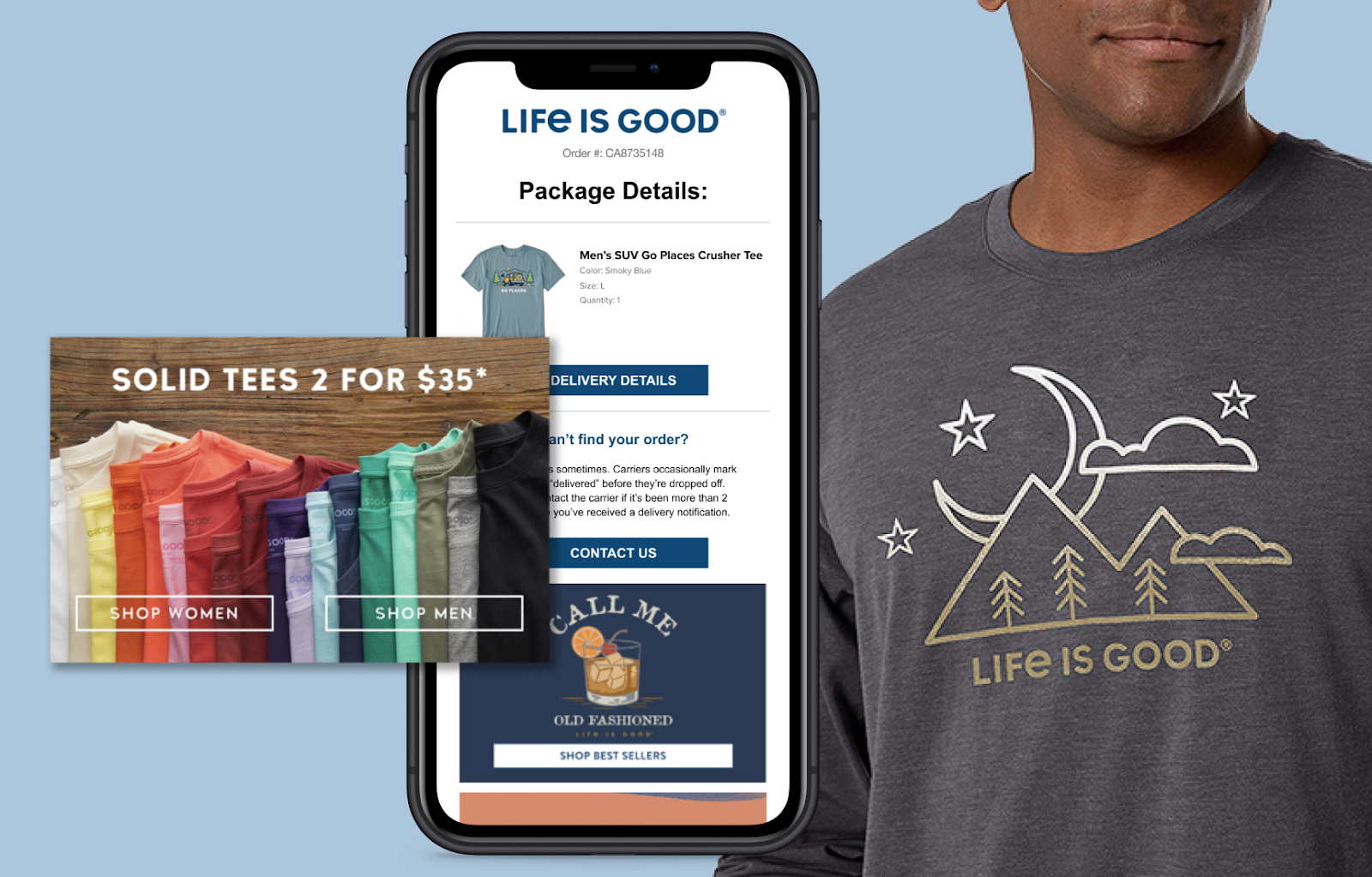
AI-powered delivery date estimates to boost conversion
Give shoppers peace of mind and protect and grow your bottom line
Personalized tracking experiences to build brand loyalty
Returns and exchanges management to mitigate fraud and reward best customers
Proactive communication to drive customer lifetime value
Delivery claim management to tackle fraud and build trust
How to Succeed With Ecommerce Remarketing

Repeat customers are critical to retail success. Retailers have a 5-20% likelihood of completing a sale with a new customer, but a 60-70% chance of selling to a returning customer. Repeat customers also tend to make larger purchases, spending 31% more than new customers. If retailers want a greater return on their marketing spend, they need to master remarketing. Unfortunately, the data suggests that few retailers give remarketing the time, attention, or money it deserves.
What is remarketing?
Remarketing is the practice of re-engaging customers who make a purchase with a brand to encourage them to make a subsequent purchase. While retargeting and remarketing are often conflated in retail, there’s a distinction between the two practices.
Retargeting refers to tracking and targeting potential customers who may have interacted with a brand in the past, but did not make a purchase. That could include sending abandoned cart reminders, pushing social media ads with products the customer viewed, or tapping into search with discounts. The idea is to find a new way to reach the shopper and convince them to buy something.
Remarketing builds upon a retailer’s existing relationship with a customer to maximize the
customer’s lifetime value (LTV). Remarketing happens through channels the customer has voluntarily established with the retailer—e.g. email, text, or mobile app push notifications.
Benefits of ecommerce remarketing
Remarketing helps brands stay fresh in customer’s minds, increasing sales in the process. It can even provide useful data for personalization. By tracking the types of messages a customer opens, and the types of products they view within those messages, retailers can hyper-focus on connecting each customer with the products most relevant to their interests or needs.
Remarketing is also an opportunity to leverage existing customers as promoters. Many brands, like Revival, a textile company that specializes in eco-friendly rugs, have referral programs that encourage customers to send their friends a shopping credit, and earn a referral bonus for each new customer they refer.

Finally, remarketing can help retailers yield a better return on their marketing budget by targeting people who are already interested in their products or services. Remember, past customers are more likely to make a repeat purchase.
Opportunities for post-purchase remarketing
Post-purchase communication includes every point of engagement after the customer clicks the buy button:
- Order confirmation
- Tracking notifications
- Delivery notices and exceptions
- Returns correspondence
- Feedback requests
- Follow-up promotions for additional products or services.
Remarketing can leverage post-purchase communication to lay the groundwork for future purchases. Customers are particularly engaged with a brand’s messaging while waiting for their orders. In this period, it’s acceptable to update the customer frequently: 98% of customers want over-communication during the delivery journey, especially if there’s going to be a delay. Customers are already opening order-related messages, so brands should seize that opportunity to promote additional items, seasonal collections, current promotions, and upcoming sales.
Narvar data shows that package-tracking emails, alone, have an open-rate around 70%, and customers view branded tracking pages an average of 3.2 times per order. In addition to providing customers with a convenient information clearinghouse, branded tracking pages allow retailers to capture engagement metrics beyond the open rates they get through email. By tracking click-throughs and conversion rates, retailers can better understand what is bringing customers back after they’ve already made a purchase, and adapt their remarketing strategies accordingly.
Cross-selling in post-purchase remarketing
The post-purchase period—when retailers have customers’ maximum attention—is a prime opportunity for cross-selling, e.g., suggesting additional items to enhance the customer’s original order.
To succeed in rapid succession sales, retailers typically need to both suggest products to the customers, and incentivize the customer to buy more. For retailers that charge for shipping, that could be an offer to consolidate the orders into one shipment if a subsequent order is placed within two hours. (The exact duration of an add-on order window will vary according to a retailer’s logistics.)

Another strategy is to offer the customer a time-limited discount on their next purchase. When taking this approach, retailers can increase the sense of urgency by highlighting companion products that are low in stock and emphasizing the duration of the discount, (i.e., “Hurry! Your 15% discount expires in 12 hours,” or “Final pair in your size.”)
Retailers that want to renew the customer relationship after a longer break can try cross-selling items to increase the longevity of the earlier purchase. If the customer bought a pair of leather boots during the fall, the retailer could try cross-selling shoe trees or leather conditioner in the spring in anticipation of off-season storage.
Personalized remarketing
Customers are inundated with marketing emails and text messages every day. Using data to personalize those remarketing messages cuts through the noise and helps brands generate repeat sales.
Personalization should start in the subject line or preheader copy. Narvar’s end-to-end post-purchase platform clients see an average +8% boost in open rates for order tracking email when personalization is incorporated in the subject line. Personalized subject lines must convince the customer that the information inside the message is worth their attention. For example:
- Fashion purchase: The vibes are immaculate. {Customer Name}, these tops will look ah-mazing with your new skirt.
- Beauty purchase: {Customer Name}, are you running low on mascara? It’s been a minute since your last order. Re-order now and save 10%.
- Specialty food items: You’ve got great taste. Protect your investment. These containers keep your ingredients fresher, longer.
AI and automation technologies make it easy to personalize remarketing communications with tailored product recommendations. These types of messages save customers time, increasing the likelihood of repeat purchases.
Leveraging returns for remarketing
Returns are part of the retail cycle. An easy return process can lead to an additional purchase: 60% of shoppers make purchase decisions based on return policies, and 96% of customers will shop again with a retailer that offers easy returns.
The best return policy lets the customer decide when, where, and how they complete their returns. By adding features such as home pickup, partner networks, lockers, and BORIS to a returns policy, retailers cultivate a happier customer who’s more likely to keep spending. Return policies can even be designed with remarketing in mind. For example, some retailers offer instant returns for customers who opt to take the refund value in store credit, or a 25% store credit bonus for customers who immediately order a new item with their store credit.
Narvar research found that 33% of retailers save a sale by offering store credit to customers. Though a credit to the original form of payment is still most shoppers’ first choice, many customers happily accept store credit when that credit is paired with instantaneous delivery (e.g., an “instant refund”) or additional value.
In 2022, 71% of retailers were offering an online return portal. Building those portals not only increases customer satisfaction with the ease of the return, it offers measurable data about customer preferences which can be used later in remarketing.
In closing…
Remarketing is an exercise in relationship-building. To be successful, a retailer has to use what they know about the customer to tailor a future experience.
Personalizing remarketing communication is easy with the right email marketing tools. Retailers can use information obtained during the checkout process (e.g., the date of the customer’s first purchase, their birthdate, etc.) to send customized communications with a promotional offer. For example, a unique discount code to celebrate their customer anniversary or a free birthday gift.
Repeat shoppers are good for business, so each step in the post-purchase journey should be building the case for future purchases. If retailers want to foster a reliably-active customer base, they need effective remarketing strategies and tools.
Get more insights from the experts
GET STARTED
Power every moment after the buy
Build trust. Protect margins. Drive growth — “Beyond Buy.”





















